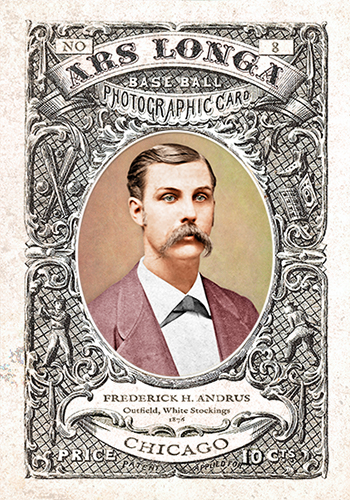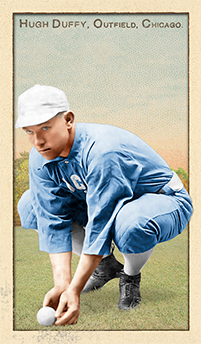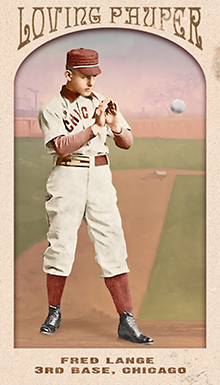
- Series: 1880s: Loving Paupers
- City: Chicago
- Team: White Stockings
- League: National League
Joseph Andrews Sommers (1866-1908) was a catcher in the days when the position exacted a heavy toll on its players. Perhaps this accounts for why Pete could last four seasons in the majors despite having no discernible skills in the batter’s box. He hit .181 his rookie year in the lesser circuit of the day, the American Association. He debuted with the New York Metropolitans, a struggling club under Dave Orr’s direction in 1887. Sommers got into a mere 33 games, but did contribute a dozen RBI. The following year Pete moved to the National League where he would remain during his major league tenure with Boston’s Beaneaters, the Chicago White Stockings, Indianapolis Hoosiers, New York Giants and Cleveland Spiders. He split the ‘89 season between Chicago and Indianapolis and was in NY and Cleveland for his final turn in 1890. Overall Sommers managed to hit a combined .198 in these four years. Nevertheless, the risks of being the backstop in the days before modern protective gear were such that a high batting average was hardly necessary to fill in at catcher and Sommers got to be part of some of the noteworthy teams of the decade. His MLB experience was less than half of Pete’s pro career. He had started out with Cleveland’s Forest Cities in the Western League in 1885 and saw limited service as late as 1896 with the Quincy, IL Ravens.
- In ‘92 Pete was a regular with the Terre Haute Hottentots (a simpler time!) of the Illinois-Iowa League where he hit .250
- During his season in the Big Apple, Sommers proved to be a sturdy oak behind the plate. News reports described a collision with Orr that left the player/manager out cold and missing two teeth. Apparently, Sommers and first-baseman Orr were trying for the same pop-up. Unknown if Pete held onto the ball
Auction History
Cartophilia
Old Judge Pose: 430-4

- Series: Mort's Reserve
- City: Chicago
- Team: White Stockings
- League: National League
Frederick Hotham Andrus (1850-1937) had the distinction of making major league baseball a part time occupation. Fred always held gainful employment but stayed close enough to the game to get two opportunities to play at the pinnacle of the sport, both with Chicago. His first brief tour was in 1876 where he played outfield in eight games for the champion White Stockings in the National League's inaugural season. He made a good record, hitting .306 in 36 plate appearances with three doubles and two RBI. Eight years later Andrus returned for a single game for the White Stockings, this time as a pitcher. He completed his start while yielding three runs, two earned, for a “career” ERA of 2.00. Andrus is known to have played for only one official minor league club, Milwaukee of the League Alliance, in 1877. He was one of two managers for the team that year along with Pidgey Morgan. Milwaukee was one of 29 teams vying in the agglomeration known as the League Alliance. It had formed in response to a perceived threat by a rival professional organization, the International Association of Professional Base Ball Players challenging William Hulbert's new National League. Spalding had managed Andrus at Chicago in '76 and was heavily involved with Hulbert in navigating the tumult as the nascent NL established itself as THE major league. In fact, Spalding had founded his famed sporting goods company in 1876, a franchise Andrus would serve as treasurer for eight years beginning with his move to Chicago in 1884. Undoubtedly, it was the high-level connections Andrus had forged in baseball and in business that gave him the entree for his cameo appearance that year back with his old Windy City team.
- Andrus had started out in his native Michigan playing for the Mutuals of Jackson, possibly a successor to one of the earliest organized clubs in America. The Daybreak Club of Jackson had begun in 1860. Jackson had another claim to fame as, in 1854, a meeting “Under the Oaks” just outside of town was the site of the founding of the Republican Party
- Fred left Spalding's company to manage a Detroit real estate concern with which he was still employed at his death from pneumonia at age 87

- Series: Beginnings: 1880's
- City: Chicago
- Team: White Stockings
- League: National League
- Hall: National Baseball Hall of Fame
Hugh Duffy (1866-1954) is as much a baseball institution as the Hall of Fame that enshrines him. For 68 years he devoted himself to the game he loved and excelled at as few ever have. In 1894 he set the all-time mark with a .440 average while winning the triple crown. He made HOF pitchers look like batting practice coaches: .586 against John Clarkson, .650 vs Cy Young. Amos Rusie was the exception, holding Duffy to a mere .333. So diminutive Cap Anson nearly dismissed him (“We already have a bat boy”), Hugh hustled his way to becoming the only player to hit .300 in four leagues and let the power follow his form (“hit ‘em up the middle”) winning two HR titles. Duffy went on to coach, manage, scout and mentor for a half-century after hanging up his spikes. He was still hitting fungoes eight years after his induction into Cooperstown and delighted in pupil Ted Williams’ success as he sought in vain to eclipse Duffy’s record in 1941.
- Playing career spanned 19 years, primarily in Chicago, Boston and Philadelphia
- Played center field for the Beaneaters next to his “Heavenly Twin,” Tommy McCarthy in right, leading Boston to a pair of pennants
- Elected to Hall of Fame: 1945

- Series: 1880s: Loving Paupers
- City: Chicago
- Team: Maroons
- League: Western Association
Frederick W. Lange began his pro ball career as a teenager (how young is in dispute). He was from the San Francisco Bay Area and played in 1886 for the Greenhood and Morans team of oakland, a charter member of the California State League. The owners were haberdashers in Oakland who sponsored the club for three years. In 1887 the team floundered in last place despite having a lot of talent. The loss of star pitcher George Van Haltren, who went east to begin a long major league career, was a big blow. Fred Lange was a pal of Van Haltren’s and followed him to NY.
There is a fair degree of uncertainty and confusion surrounding Lange’s career, some of which appears to have been instigated by Lange himself. He had changed his surname to "Dolan" to sign with the G & Ms in Oakland so his parents wouldn’t know of his unworthy occupational choice. (Anyone familiar with the American Association’s reputation as the “beer and whiskey league” can sympathize with Fred’s folks as the 1880s were an era of free-wheeling debauchery in big time baseball.) But there is a reference by authors Dick Dobbins and Jon Twichell in their book Nuggets on the Diamond:Professional Baseball in the Bay Area from the Gold Rush to the Present, published in 1994, to the effect that Fred Lange was also “Willard Brown,” who went on to play for the NY Giants after leaving Oakland in 1886. Catcher William "California" Brown did play for the Giants from 1887-1889 and, perhaps not coincidentally, had played for Greenhood and Morans as well. Adding to the confusion, the editors of The Photographic Baseball Cards of Goodwin & Co mistakenly list William Brown as "Willard" in that seminal encyclopedia on the Old Judge universe. One possible theory to the confusion, however unlikely, is still intriguing: In moving East to pursue his big league dreams, might Fred Lange have adopted the name "Willard Brown" as a sort of hopeful and opportunistic nominal doppelganger to William Brown?
The truth is, most likely, that the mystery and confusion around Fred Lange's name and identity is the result of a more modern human error and that there is no mystery at all. Fred Lange & William Brown are clearly different people, perhaps even friends, who look nothing alike and appear together in a Greenhood & Morans team photo from 1886, thereby dispelling the notion that Brown was Lange's alter ego. Furthermore, there is no record of a "Willard Brown" playing professional baseball in the 19th century and the Old Judge folks were unconfused on the players' identities, with each player getting five unique poses in the series with no misspellings, overlay or confusion between them. Given that Van Haltren knew both Lange and Brown and that Van Haltren and Brown had quickly established themselves as bone fide big leaguers, it seems unlikely that Lange would attempt to perpetrate such a thinly veiled con while striving to join his friends on the big stage.
- Further adding to the confusion around Lange's name, the New York Metropolitan Museum of Art mistakenly lists Lange as "Lance" for the two Old Judge cards of Lange that reside in the museum's collection.
- Lange later authored an influential tome of his own: History of Baseball in California and Pacific Coast Leagues (1847-1938)
Auction History
Cartophilia
Old Judge Pose: 272-4

- Series: Beginnings: 1880's
- City: Chicago
- Team: Maroons
- League: Western Association
George Brinton McClellan Rooks (nee Ruckser) (1863-1935) had a vanishingly brief stint in the National League, seeing action in five games in left field for the Boston Beaneaters in May of 1891. He had a grand total of 20 plate appearances with 16 official at bats. He had twice as many walks as hits and ended his tour in the majors with a .125 average. He did score a run, allowing him to approach home plate from an alternate direction. This sketch doesn't do justice to a much longer professional experience for the young Chicagoan who had debuted with the Lincoln Tree Planters of the Western League in 1886 before moving on to the Northwestern League's Oshkosh franchise to finish the season. George remained in the league the following year with the LaCrosse Freezers where he was a regular. He hit .333, higher than any teammate with as many at bats. He showed both power and speed with four home runs and 70 stolen bases. Rooks got a cup of coffee in '88 with his hometown Maroons but got into only eight games before being shipped out to the Lima Lushers of the Tri-State League. 1889 would be the second and last time George played an entire season for one team, this time with the Detroit Wolverines of the International League. He was one of four to play 112 games and he produced a fine .303 average, second on the club among regulars.
- Following his sojourn in Boston, Rooks finished out his minor league career primarily close to home with clubs in Wisconsin and Michigan, including the intriguing bi-city squad from Ishpeming-Negaunee in 1892
- George strayed south for his swan song in '93 with Vicksburg of the Mississippi State League
- Although Baseball Reference data list George as right-handed, the Old Judge poses when he was with the Maroons depict a lefty both at bat and throwing




